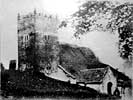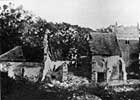 Bulcote Bulcote
Holy Trinity
History
The village of Bulcote is recorded in the 1086 Domesday Book. It was already
an established village over-lorded by Walter D’aincourt, a Norman knight.
The De Busli family rented the land from about 1080 to 1099. From the list
of householders the population in 1086 has been estimated to have been about
132. At that time the neighbouring village of Burton
Joyce had only 50 inhabitants, but it had a church and a priest whilst
Bulcote did not. The population level of the village remained more or less
constant for over 900 years until housing developments in the 1960s increased
it to 252 by 1971.
The church is said to have been founded by the Sancta Maria family who held
the lordships of both Bulcote and Burton Joyce from early in the 13th Century.
They resided in Bulcote, living in a house named St Mary’s Hall,
the exact site of which is not now known. Adam Sancta Maria gave the church
site for the burial of his wife Alice ‘so that she was buried in hallowed
ground’. Alice died between the years 1208 and 1213. Presumably the chapel
was built around the same time, for soon afterwards he gave the site and some
land in the village to the Abbott of Welbeck Abbey, a Premonstratensian order,
with the condition that they would supply a priest ‘for the sake of
the souls of my wife Alice and son Bartholomew’. Some time before 1349
Welbeck transferred the church and land to Shelford
Priory, an Augustinian
order, in exchange for the advowson of Kelham near Newark. It is not known
if the church was originally dedicated to the Holy Trinity or had some other
name, but it has been known as Holy Trinity Church from at least the 17th Century.
Shelford was a small Priory and an early target for dissolution, which happened
in 1536. Sir Michael Stranhope appropriated both the Bulcote and Burton
Joyce churches along with many of the assets of Shelford Priory. Stanhope and
his successors appear to have cared little for Bulcote church for in 1592 the
records of the Archdeacon’s Court record that ‘the chancel of the
church be decayed due to his default’. In 1602 the churchwardens where
summoned to appear before the Archdeacon because ‘the belfry is out of
repair’. Thomas Burrage one of the church wardens duly appeared, the
other warden did not. The Archdeacon ordered that they should both attend him
in fifteen days time. In December they where again summoned to the Archdeacon’s
court because the work had not been completed. We have no record of how much
or if any work was done, but in October 1603 they once again faced the Archdeacon.
Although we do not have details of the charge it is most likely because the
instructions of the previous year had not been carried out. Both ignored the
summons and the Archdeacon promptly excommunicated them.
Like many churches today Holy Trinity was regularly in need of repair and
maintenance. In 1683 it was said to be in ‘need of repair’ In 1718 ‘the
chancel roof, windows, pavement and the south wall’ were reported as ‘being
in need of pulling down and rebuilding’. On this occasion drastic action
by the Archdeacon was not needed. The work was duly completed and the church
reported to be ‘repaired in every respect’.
Bulcote church being a chapel of ease to St Helen’s
Burton Joyce does not now have a vicarage, but in 1753 it did, for the
Archdeacon recorded that the building was in need of repair. There is no
further information regarding the vicarage or its location. Bulcote village
and the surrounding lands were enclosed by Act of Parliament in 1786. The
church was awarded Bulcote Wood and other tithe lands, which produced an
income of £47 per annum. Throsby’s 1796 description of the building
was not very generous ‘The chapel which is topped like a pidgeon house
has no attractions’
The population of Bulcote reached its highest 19th Century level in 1841 when
the census returns give a figure of 156, but ten years later in 1851 the population
was just 83. This is also the population figure recorded for the Religious
Census conducted in the same year. The return for Holy Trinity recorded that
the general congregation was 32 plus 16 Sunday school scholars. Thirty was
claimed to be the average number of attendees. Only one service, on Sunday
afternoon, was conducted each week. The census also recorded that the church
at that time had a singing loft, and seating for about 130 people
By 1859 the church was in a very poor state of repair, so much so that the
vicar closed the building for further use. The responsibility for the upkeep
of the church was vested in the Lord of the Manor who in 1859 was major, later
Colonel Egerton-Leigh. He had acquired the title and properties including Bulcote
Lodge, through his marriage to Lydia Rachel Wright. (Her mother, also Lydia,
was interned in the family vault in the chancel of the old church.) Egerton-Leigh
resided at his family seat High Leigh in Cheshire, renting out his Bulcote
estate. Although he was an absent landlord he took his responsibilities seriously.
In 1860 he wrote to the Church Commissioners informing them of the condition
of the church. He had already ascertained that the cost of a new building would
be about £900. Egerton-Leigh stated that he was prepared to personally
contribute £750 towards the total costs. His request for the remaining £150
was refused.
 Photograph
of the Photograph
of the
old church c.1858
|
 Photograph
of the Photograph
of the
remains after the
church's collapse |
Fate then moved to resolve the problem. In July 1861 Egerton-Leigh’s
tenant of Bulcote Lodge, Miss Maria Popplewell, was sat at the window
of her upstairs dressing room watching a violent thunderstorm, when she witnessed
lightning strike the church, which collapsed. The vicar, Rev John Rolleston,
photographed the ruined church soon afterwards and a copy of his picture now
hangs in the present building. The event was widely reported in newspapers throughout the country.
The landowner, Colonel Egerton-Leigh, together with other
local inhabitants, funded the building of a new church at a cost £900. It was opened on 2 August 1862 by the Lord Bishop of Lincoln. The architect was Thomas Bower of Nantwich, Cheshire and the contractor was Mr Palmer of Lowdham.
 Date
stone on the Date
stone on the
east end of the apse |
Unfortunately, in the rush to rebuild no one thought to ask for a faculty, which had
to be granted retrospectively in July 1862 '‘for the purpose of ratifying
and confirming the building of the said chapel, and constituting the chapel
as the chapel of the said chapelry in place of the ancient chapel which has
so fallen down.'
Holy Trinity sits on a hill site made more prominent by the realignment of
the A612 road. It is illuminated in the evening and tastefully lit during the
Christmas period, standing as a silent, but by no means abandoned or insignificant
beacon, admired by most who pass by. It has however not attracted such complimentary
notice in the past. The Nottingham Guardian carried an article about
Bulcote village in its edition of 20 November 1943. It only mentioned the church
in the last few lines, stating that ‘the medieval church was replaced
in 1862 by a structure of no outstanding interest’. Pevsner (1951) was
equally dismissive affording it only six words: ‘Holy Trinity, 1862 aisleless
and towerless’. The church remains active today with regular Sunday services
each week. The burial ground is also still in use, and managed in such a way
as to provide a wild flower habitat seen at its best in the spring.
| 


 Photograph
of the
Photograph
of the Photograph
of the
Photograph
of the






